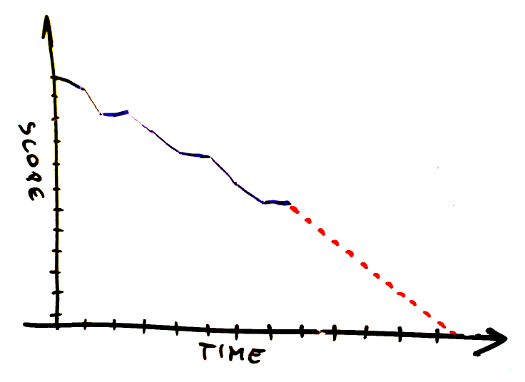The other day I was in the middle of discussion about visuals a team was going to use in a new project. When we came to the point of tracking completion of the project I advised a burn-up chart and intended to move on. The thing that stopped me was the question I was asked: why burn-up and not burn-down?
Burn-down Chart
First, some basics. Burn-down chart is an old idea I’ve learnt from Scrum. It is a simple graph showing amount of work on a vertical and timeline on a horizontal axis. As time progresses we keep track how much work is still not done. The goal is to hit the ground. The steepness of the curve can help us approximate when it’s going to happen or, in other words, when we’re going to be done with the whole work.
When we think about quantifying work it should be anything we use anyway – story points, weighted T-shirt sizes, simple number of tasks or what have you.
Burn-up Chart
Burn-up chart’s mechanics is basically the same. The only difference is that instead of tracking how much work is left to be done, we track how much work we’ve completed, so the curve is going up, not down.
The Difference
OK, considering these two work almost identically, what’s the difference? Personally, I don’t buy all the crap like “associations of the word burn-down are bad.” We learned not to be afraid of failure and we can’t deal with a simple word? Give me a break.
The real difference is visible when the scope changes. If we suddenly realize we have more work to do burn-down may look like this.
Unfortunately, it can also look differently if we happen to be (un)lucky enough to complete some work at the same time when we learn about additional work.
It becomes even trickier when the scope decreases.
Have we just completed something or has a client cancelled that feature which we talked about yesterday? Not to mention that approximating the finish of work becomes more difficult.
At the same time, burn-up chart makes it all perfectly visible as progress is tracked independently on scope change.
You can see scope changes in both directions, as well as real progress. And this is exactly why choosing burn-up over burn-down should be no brainer.






